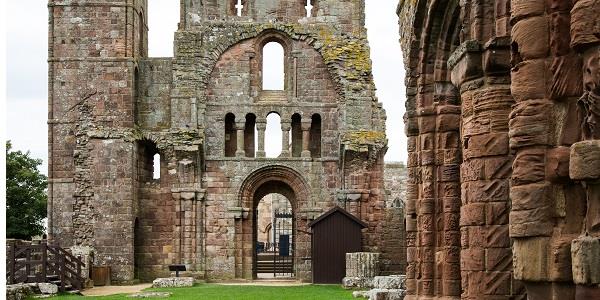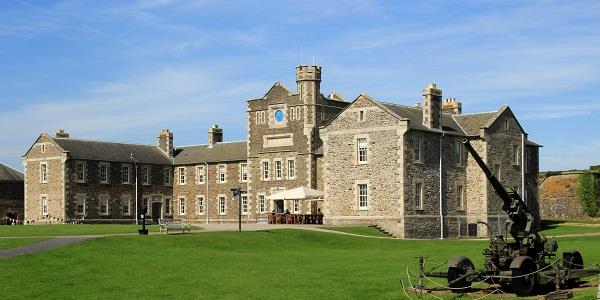
Header image: Rievaulx Abbey near Bell End Farm
Article by Roly Smith
A common, but somewhat sexist, remark is that an Englishman’s home is his castle. But as guests at Bell End Farm will discover, an Englishman’s castle can also be his (or her) heritage, thanks to the national ancient monument charity, English Heritage (EH).
EH now manages over 400 historic monuments, buildings and sites throughout the country. As we’ll discover, many of these are close to Bell End Farm and our other English properties. The EH sites range from enigmatic prehistoric sites, Roman forts, forbidding medieval castles, impressive monastic ruins, grand country houses and even to an ominous Cold War bunker.
The charity’s claim that its properties “bring the story of England to life for over 10 million people each year” surely cannot be denied. It’s true, a visit to any can get you up close and personal to where history actually happened, allowing you to explore the places which made England what it is today. For many visitors to Bell End Farm, as well as our other properties, these sites can be a highlight of their holiday.
If we take a chronological tour of England, visiting historic EH sites close to our English properties, you can see how closely the history of the country is woven into the landscapes close to our holiday homes. (NB: ‘D’ after the site indicates that dogs are allowed on leads; ‘W’ that there is disabled access, and ‘C’ that there is a children’s play area).
As L P Hartley famously claimed in the opening line of his 1953 novel, The Go-Between: “The past is a foreign country: they do things differently there.” That’s certainly true of the vast epochs of unwritten prehistory before the Roman invasion of AD 43.
We can only make educated guesses about how Neolithic, Bronze Age and Iron Age Britons lived. But the monuments they left behind, mostly earthworks or monolithic stone structures which have withstood the ravages of time, can remind us of these long gone and forgotten communities which were the first to populate these islands.
Perhaps most famous are the monuments which punctuate the Wiltshire downs around the impressive stone circles of Stonehenge (W) and Avebury (W), now encompassed as a World Heritage site. But for its impressive, mountain-ringed setting, nothing can beat the Neolithic Castlerigg Stone Circle (D) just outside Keswick, and close to our Braithwaite Court and Ivy House Hotel properties, which themselves are just two miles west of Keswick.

Image: Castlerigg Stone Circle
Castlerigg is one of the earliest stone circles in the country, thought to have been constructed about 3000 BC and in 1883 it became one of the first monuments to be recommended for preservation by the nation.
Arbor Low (D), the so-called “Stonehenge of the North” lies just up the A515 from Blore Hall in the Peak District, and although its limestone monoliths now lie prostrate on the sheep-cropped grass, it exudes far more of a sense of the past than its over-interpreted Wiltshire counterpart.
The 1979 Monty Python film Life of Brian famously asked the rhetorical question: “What have the Romans ever done for us?” The answer of course was quite a lot, and visitors staying at Lucker Hall near Bamburgh are ideally located to inspect several EH sites along Hadrian’s Wall, including the Birdoswald (D,W), Chesters (D), Corbridge (D,W) and Housesteads (C,D) Roman Forts.
The Roman forts designed to protect the Saxon Shore at Burgh Castle (D) and Caister (D) are both close to Barnham Broom, and you can see how luxuriously the upper classes of Romans lived at the Lullingstone Roman Villa (W), near Sibton Park, Lyminge in Kent.
The so-called Dark Ages were really anything but, as a visit to Lindisfarne Priory (D,W), Tynemouth Priory (D,W) and Whitby Abbey (D,W) also close to Lucker Hall, will show. The flowering of Christian art and culture, particularly in the north east of England, gave us such priceless artefacts as the Lindisfarne Gospels and the intricately carved Celtic crosses such as those at Bewcastle and in the market square of Sandbach (D,W) in Cheshire.

Image: Lindisfarme Priory
Nearly half of all English Heritage properties date from the Medieval period. So, if it’s castles you are after, then there are plenty of properties close to places which will satisfy the most ardent fortress fanatic.
Upper Norton, near Ludlow, is convenient for a visit to ruby-stoned Goodrich Castle (D) high on its impressive crag above the River Wye, and Beeston Castle (D) with its views across eight counties and to the distant Welsh mountains. While staying at Barnham Broom, close to the cathedral city of Norwich, you can admire one of England’s finest baronial fortresses at Framlingham Castle (D,W) or Castle Rising Castle (D,W) and you can visit one of the best-preserved monastic sites at Castle Acre Castle and Priory (D) near Swaffham.
The northern medieval strongholds of Middleham Castle (D,W), Richmond Castle (D,W), Helmsley Castle (D,W) and Scarborough Castle (D,W) are all within striking distance of the properties at Bell End Farm, Rosedale, in the North York Moors and Lodge Yard and the King’s Arms Hotel, at Askrigg in the Yorkshire Dales.
Northumberland is noted as a county of magnificent coastal castles and Warkworth Castle and Hermitage (D,W), Dunstanburgh Castle (D) and Norham Castle (D,W) are all conveniently close to Lucker Hall.

Image: Rievaulx Abbey
One of the most beautiful and sublimely situated of monastic ruins in the country can be found at Rievaulx Abbey (D,W) in Ryedale, near Helmsley in the North York Moors. This is easily accessible from Bell End Farm, Rosedale, which itself is the site of a former Cistercian nunnery. So is Whitby Abbey (D,W), high on its cliff above the fishing port, and Mount Grace Priory (W), one of the last of the great Yorkshire monasteries and now an Arts and Crafts masterpiece, six miles from Northallerton.
Augustinian Lanercost Priory (D) is less than half a mile from Hadrian’s Wall near Brampton in Cumbria and accessible from Lucker Hall and the Braithwaite Court and Ivy House Hotel properties at Keswick.
If you are headed for the Cotswolds and aiming to stay in one of 12 stone-built cottages at Buckland Court, near Broadway, you will be handily-placed to visit the Cistercian Hailes Abbey (D,W) near Winchcombe, with its recently transformed museum of treasures, or Cleeve Abbey (D,W), near Washford, with its striking tiled pavements. You won’t be too far from the beautifully-restored Elizabethan gardens in the grounds of Richard of Gaunt’s Kenilworth Castle (D,W) either.

Image: Pendennis Castle
Pendennis Castle (D,W), a Tudor fortress built by Henry VIII overlooking the Fal estuary in Cornwall, is convenient for a visit from the elegant Queen Anne mansion of Duloe Manor near Looe.
If the stately homes of Old England take your fancy, then you won’t go far wrong with a visit to Belsay House (D,W) in Northumberland, not far from Lucker Hall, or Audley End House (D,W,C) near Saffron Walden, not too far from Barnham Broom. The recently-restored fairy-tale Bolsover Castle (D,W,C) is a unique Stuart mansion created by William Cavendish, Duke of Newcastle and easily visited from Blore Hall in Derbyshire.
We are nearly up-to-date in our time travelling tour of England. One of the first manifestations of the world-changing Industrial Revolution took place in the valley of the River Severn at Ironbridge (D,W), where Abraham Darby III built his famous Iron Bridge in 1779. The elegant Georgian farmhouse of Upper Norton, near Ludlow, is close by.

Image: Ironbridge
Charles Darwin’s theory of the origin of species by natural selection has been called “the greatest idea ever.” His modest Victorian country home of Down House (W), near Downe, Kent is preserved in its original state by English Heritage and can be visited from Sibton Park, near Lyminge.
Finally, a chilling reminder of the threat of a nuclear Armageddon during the Cold War can be experienced at the York Cold War Bunker (W), a mile and a half from the city centre. Here volunteers from the Royal Observer Corps watched for the fateful signs of a Russian attack within a brutalist concrete bunker. It can be easily visited from Rosedale.
Find out more about how you can stay at one of our many holiday properties across the UK and Europe.

